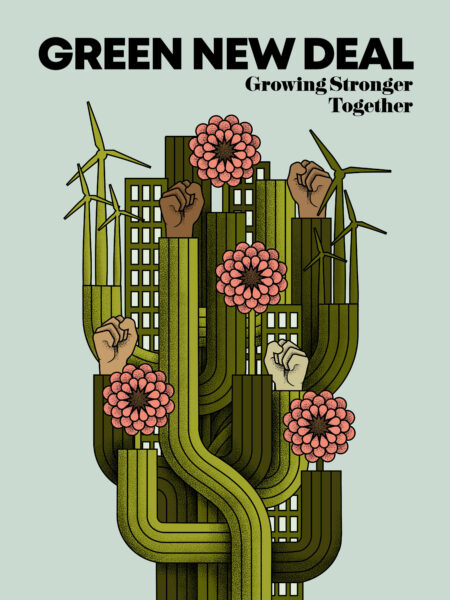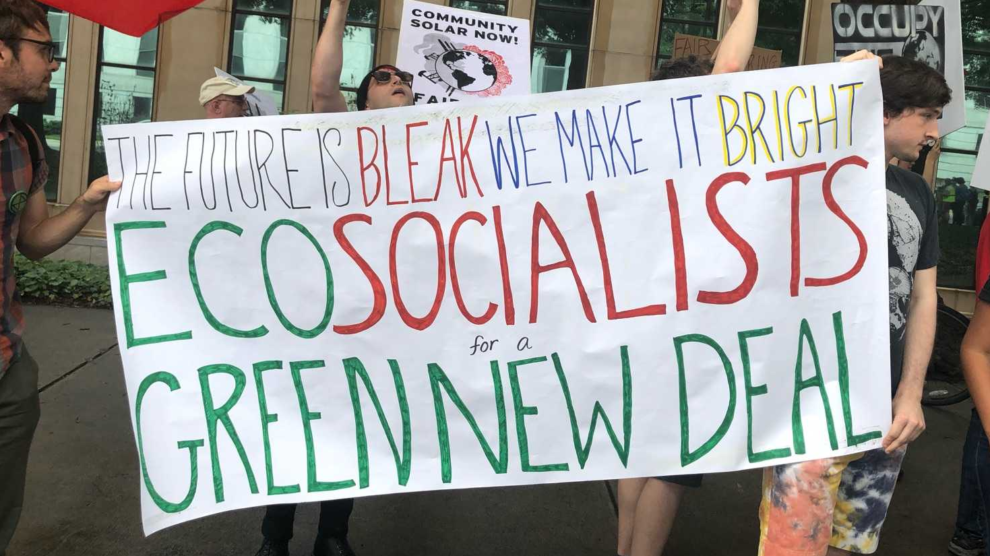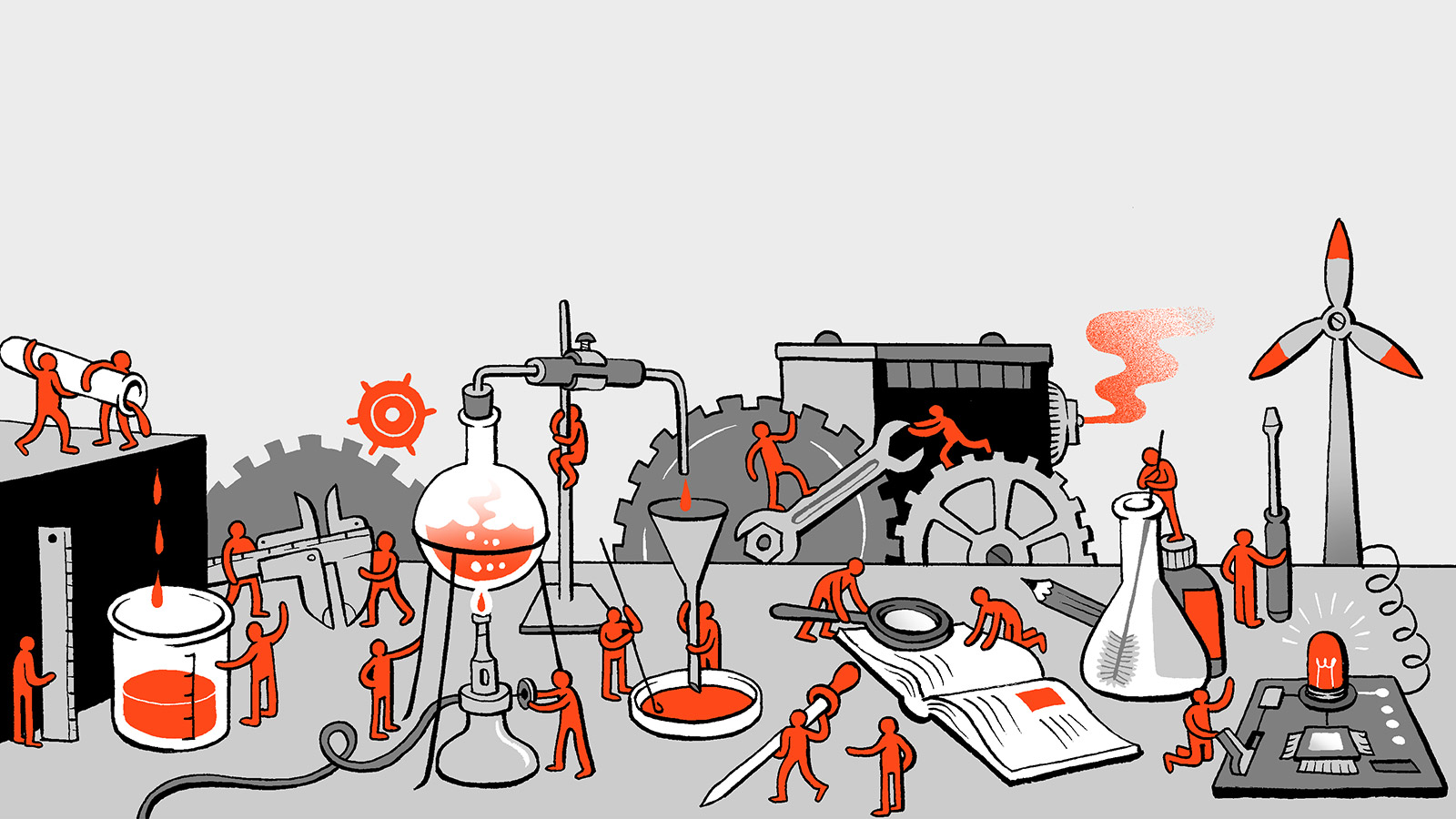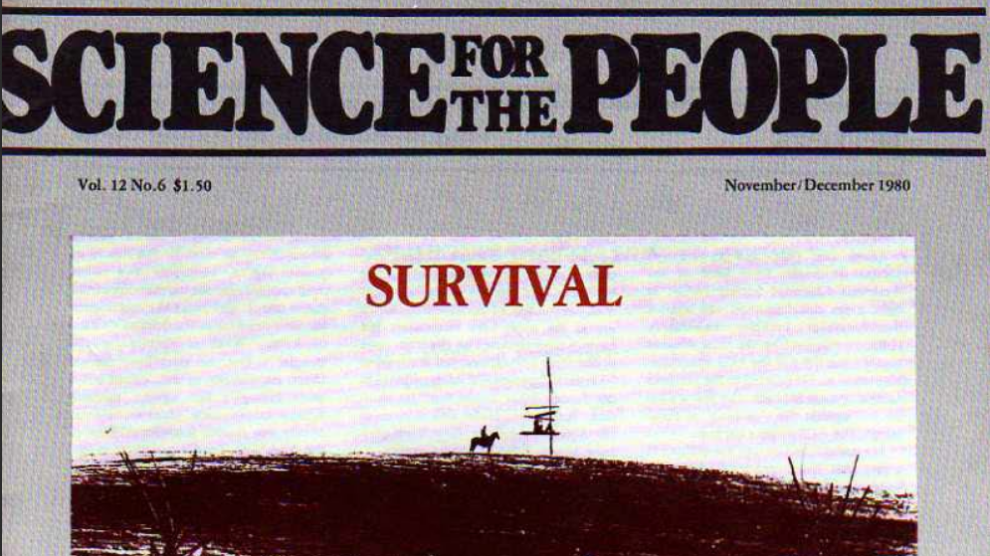A Climate Strike-Inspired Union Drive
Volume 23, number 2, People’s Green New Deal

A group of workers at a government sustainability agency are trying to form a union. Like other similar organizations at the state and municipal level, the agency’s mission is to promote renewable energy, reduce greenhouse gas emissions and pollution, and create green jobs and economic opportunities. Employee grievances have piled up due to understaffing; loss of benefits; arbitrary decision-making in hiring, pay, and promotions; lack of transparency about the agency’s strategic decision-making; and lack of progress in achieving the agency’s goals.
The seed for this union drive came out of the workers’ organizing for the September 2019 youth-led climate strike. Science for the People sat down with three of the leaders of this effort, who must remain anonymous due to the sensitive nature of the campaign. Employee names have been changed to protect the identity of the workers.
SftP: How did this organizing get started?
Donna: There were all these staff around the agency with different experiences who hadn’t had a space to come together to talk about their frustrations and concerns. Wanting to get involved in the climate strike provided a catalyst for that.
Mike: It was interesting at the time, just the act of forming a WhatsApp group to coordinate going down to the climate strike together made such a change. We could all communicate as a group, and that space just opened up.
SftP: What are some of the issues motivating this?
Donna: What we’re doing at work, and how we’re doing it—is it really up to the task of tackling climate change? I mean, the real task and not just the political one?
Nathan: Many of us are motivated by the mission of the agency. But that isn’t coming through in the actual work. When we finally got together, we thought, “Oh, I’m not the only one feeling this way.” And that’s why we need a union. For workers to say that we have a stake in this.
Mike: After working here for a little while, it became apparent that there was a disconnect. There was a lot more emphasis placed by management on how great our goals are, and very little emphasis on discussing critically why the results weren’t following. When you have a bunch of employees who are doing the work because they feel committed to the mission, and you’re not willing to acknowledge that gap—it’s demoralizing.
That was the first time I personally learned how extensive some of the basic workplace issues were. This person is getting screwed over, that person is getting screwed over, that other person is getting screwed over. This is just like a lot of other workplaces, it’s not this feel-good story that we’re always talking about publicly.
Nathan: We are also cognizant of the long-term effects of internal decisions made without worker input. We’ve seen a couple stark examples of that recently. A lot of people were forced into retirement in recent years. And even now, under different leadership, they are taking away some of our benefits.
SftP: Can you say more specifically about why a union? This is a workplace focused on sustainability, where management “gets it” and is generally on board with a progressive vision. It’s interesting that you feel a union is needed.
Mike: When this group came together, the union question wasn’t obvious. We had a couple of discussions early on after the climate strike, where we were like, “What do we do with the energy of this group?”
Donna: We had to talk through a lot why a union is needed. What kind of leverage could we have and still be safe in our jobs? Both about the mission-related issues and about the workplace issues. In those early conversations, some of us were hesitant about even thinking about unionization, even though other people were already saying, “The only way we can do this securely is with a union.”
Nathan: It’s the one mechanism we know that has legally-enshrined rights that we knew existed. And we’re in a union-friendly sector, the government, so that seemed like the path of most security.
SftP: Many of the people involved in this campaign are people of color. I’m curious what you think about racism, or issues of equity and representation in the workplace? How did that motivate this campaign?
Nathan: [Black and Brown employees] were ahead of the curve in solidarity, in speaking openly to each other, sharing experiences and grievances across departments, talking about opaque decision-making with hiring and promotions, and about a disconnect with management.
You also have to look at the broader background. Renewable energy has been this thing that’s super white. Climate activism has forced this issue to become more diverse over the past six to seven years and more focused on frontline communities. I don’t think management understands that. They are not “climate people.” They’re people who love wind energy, who love solar energy. It’s a different type of background. They’re focused on how to get more clean energy in the market with the business community, and not piss off the establishment. And we’re like, we don’t care about that. We just want to not have the world end.
SftP: In most versions of the Green New Deal (GND), there would be a massive expansion of government funding for climate solutions. Presumably, there would also be a major expansion of the government workforce tackling this issue. How does what you’re doing fit into that, if it does at all?
Donna: We’re given so little to work with in terms of both funding and people. We need to throw as much as we can at this problem in order to really have an impact. And we’re not seeing that happen. There’s so much opportunity to bring in other voices, other communities, to get all hands on deck.
Nathan: I envision a GND to be a massive ramp-up in money spent on new infrastructure for carbon reductions and clean energy. But I don’t expect that to be a forever thing. Say we have massive build-up of high-speed rail, or renewable energy sources, or carbon sinks—there’s a role for unionized labor there. But once we have the solutions in place? There’s a logical pull back and that money can go elsewhere. What we need is mobilization to try out a bunch of different solutions that could work. And then after that, let’s have the discussion about where a large, organized workforce is needed, and other places where stuff is more automated and there aren’t as many jobs.
Mike: The current strategy is to execute the clean energy transition with as little change to the status quo as possible—just focus on seeding the right businesses that can do the clean energy transition for us.
With the scale of the climate problem, that approach is never going to work. This is an issue that impacts everybody in their daily lives in a million different ways. If someone doesn’t mobilize a much broader response to this, we’re never actually going to solve the problem. The entity that’s best positioned to do that mobilization is the government.
Nathan: The status quo politicians now really think that the system can stay the same, we just need to make it carbon-free. The system can’t stay the same. The system is the disease. Climate change is simply a really bad symptom. So you can try to find a cure for that, but then the system will create another symptom that’s equally bad. So, maybe we try to fix everything, now. That’s the thing about the GND. It talks about inequality, it talks about healthcare. It’s pumping so many antibodies to kill the disease of capitalism, and the idea is that we can come out of this with something so much better.
Donna: This question about the GND is less about the act of just forming unions. Our agency is perpetuating the status quo. Through this unionization effort we are trying to raise the alarm in our workplace towards mobilization. Not having that mobilization is affecting us in our workplace: we don’t have enough resources, we’re spinning our wheels, it’s affecting us personally, we’re being worked to death and not seeing results.
SftP: How has the COVID-19 pandemic impacted your ability to organize?
Mike: It has brought into focus the urgency of what we’re doing and the reality that it’s up to us to protect ourselves. I say that as it relates to our basic health and safety: management and the political leadership they answer to really dragged their feet in closing down our offices and allowing us all to telework when the pandemic had already become quite serious. And it also relates to our basic pay and benefits; now that we’re dealing with this economic crisis, it’s very likely that management will be looking to save money off the backs of all public employees. And there will be political pressure to de-emphasize the need for economic transformation to address climate change, because we just need to “restart the economy as quickly as possible.” As workers, we can’t have a meaningful influence in these areas unless we get organized. We’re still teleworking, so that will create some challenges in talking to our colleagues about the union. But on the other hand, we can make a very clear case about why this is needed right now.





